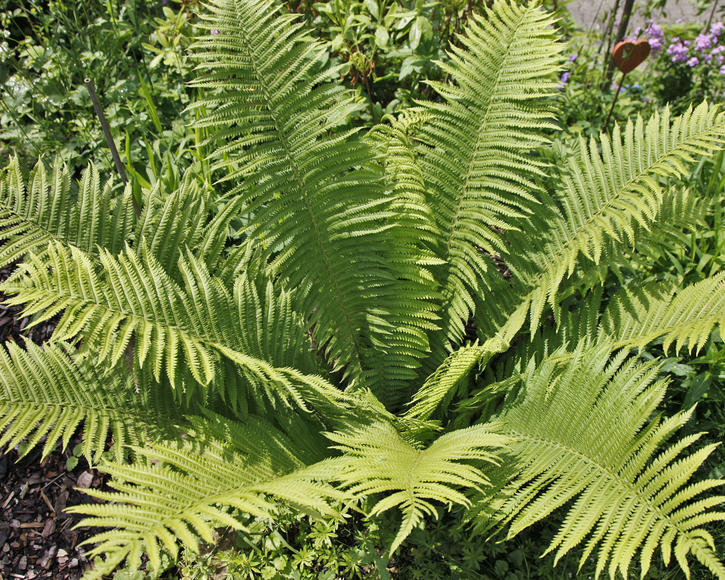Ostrich Fern
The Ostrich fern is one of the biggest and most beautiful ferns native to Europe. It unfurls its long, graceful ferns under trees and in lightly shaded garden beds. How to plant and care for it properly.
Factsheet
- Growth type
-
- rhizome
- Fern
- Growth height (from)
- from 80 cm to 140 cm
- Growth width (from)
- from 80 cm to 100 cm
- Growth characteristics
-
- sweeping
- upright
- foothills
- Leaf color
-
- green
- page format
-
- broad lanceolate
- fiddly
- duster
- Light
-
- semi-shade to shady
- Soil type
-
- gravelly to sandy
- Soil Moisture
-
- fresh to humid
- ph value
-
- neutral to weakly acidic
- Lime compatibility
-
- sensitive to lime
- Nutrient requirements
-
- nutrient-rich
- Humus
-
- rich in humus
- Decorative or utility value
-
- Leaf ornaments
- native wild plant
- Toxicity
-
- non-toxic
- Winter Hardness
-
- hardy
- Climate zones according to USDA
-
- 3
- areas of life
-
- G2
- G3
- GR2
- GR3
- Use
-
- Group planting
- Pond planting
- Underplanting
- Wilderness
- Surface greening
- Garden style
-
- natural garden
- Park area
- Forest Garden
- Water garden
The ostrich fern (Matteuccia struthiopteris), also known as the shuttlecock fern, is native to Central Europe. Together with the Japanese ostrich fern (Matteuccia orientalis) and the American ostrich fern (Matteuccia pensylvanica), neither of which exist in Europe, it belongs to the genus Matteuccia. The genus is assigned to the terrestrial fern family Onocleaceae. The ostrich fern is most commonly found in cooler parts of Central Europe like Scandinavia and Finland, but also exists in more southern regions such as the Po Valley in Italy, in Romania, and in Ukraine. The ostrich fern is at risk of extinction in Germany and is therefore protected.
The deciduous ostrich fern is an impressive ornamental foliage plant that grows up to 55 inches tall. It forms a rosette of attractive funnels and a broad rhizome which ensures that the ostrich fern grows in rows in the flower bed. Its rigid, upright growing fronds bend slightly outwards at the tips, giving the plant a very elegant appearance.
The green leaves of the ostrich fern are broadly lanceolate and pinnatisect. The light green fronds unfurl in April and look very attractive alongside spring bloomers. The outer leaves are sterile (trophophyll) and only used for photosynthesis. The inner spore-bearing leaves of the ostrich fern (sporophylls) are narrower and resemble an ostrich plume, hence the name ostrich fern. When the spores ripen in July and August, the leaves are dark brown in color and covered with two rows of sori (groups of spore-producing receptacles).

The ostrich fern naturally appears in riparian wetlands. It grows close to the water by streams and ponds. It therefore needs light to partial shade in the garden as well as high air and soil humidity. When selecting a location, make sure that there is plenty of space in all directions so that the green fronds can unfurl nicely.
The ideal soil for ostrich ferns is very moist, nutrient-rich, and low in lime. Gravelly and sandy alluviums with a slightly acidic pH are preferred. The ostrich fern cannot tolerate dry conditions.
The best time to plant the ostrich fern is in spring. Plant no more than three specimens per 1.2 square yards, leaving a distance of 30 inches between plants. Before planting, dip the fern rhizome in water and plant a little deeper into the soil in pots. Then water it well. If you want to prevent the ostrich fern from spreading, it is best to plant the fern in a pot in the flower bed or to use a rhizome barrier.
The ostrich fern is very easy to care for in the right location and does not need to be pruned or fertilized. The dead fronds can be removed in winter. It must be watered in dry conditions.
The ostrich fern can be divided if it gets too big or for propagation. To divide the fern, uncover the rhizome in early spring and split it into several pieces with at least one shoot bud. Plant the individual pieces in pots with nutrient-poor potting soil and make sure to keep this moist. Overwinter the pots in a bright, frost-free place and plant the ostrich ferns out the following spring.
The elegant funnel-shaped fronds of the ostrich fern look amazing in groups. They look fantastic planted in large numbers under trees and shrubs. The ostrich fern produces many runners and tends to spread, making it more suitable for larger gardens. It’s a wonderful pond edge plant as it likes to be close to water. The plant goes well with bulb flowers in spring.

The Ostrich fern spreads very well in flower beds through its rhizomes. The spores are dispersed in the wind, ensuring that new ferns will appear in different parts of the garden. The easiest way to propagate the ostrich fern is by dividing it (see above).
The Ostrich fern is resistant to disease. And there is no risk of pest infestation or damage from snails and slugs.

